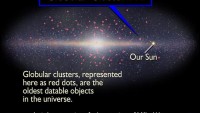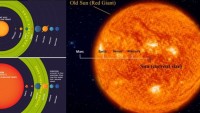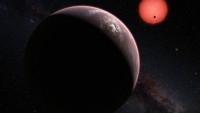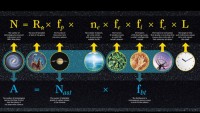Life in the Universe Might First have Formed on Carbon and Diamond Planets
| Arthur Dominic Villasanta | | Jun 08, 2016 09:48 PM EDT |
(Photo : Christine Pulliam (CFA), NASA/SDO) A carbon planet orbits a sunlike star in the early universe. Blue patches show where water has pooled on the planet's surface, forming potential habitats for alien life.
New research shows life in the early Universe might have been born on "carbon planets," a finding that strengthens the argument that life, including intelligent life, does indeed exist somewhere out there.
A Harvard University study argues life might have evolved on carbon planets made up of graphite, carbides and diamond despite the absence of carbon and oxygen that are necessary to create life as we know it. In contrast, the Earth consists of silicate rocks and an iron core plus abundant water.
Like Us on Facebook
The study said the primordial Universe consisted mainly of hydrogen and helium. Only after the first stars exploded into supernovae and seeded the second generation with carbon and oxygen did planet formation and life become possible.
The study noted that young planetary systems lacking heavy chemical elements but relatively rich in carbon could form worlds made of graphite, carbides and diamond rather than Earth-like silicate rocks.
The research suggests the first potentially habitable worlds to form might have been very different but were hospitable to life. It noted that astronomers might find these "diamond planets" by searching for a rare class of stars known as "Carbon-Enhanced Metal-Poor" stars or CEMP stars.
"This work shows that even stars with a tiny fraction of the carbon in our solar system can host planets," said Natalie Mashian, study lead author and Harvard University graduate student.
"We have good reason to believe that alien life will be carbon-based, like life on Earth, so this also bodes well for the possibility of life in the early Universe," she adds.
CEMP stars contain only one hundred-thousandth as much iron as our Sun, meaning they formed before interstellar space was widely seeded with heavy elements. These very old stars have more carbon than might be expected given their age.
This abundance of carbon would influence planet formation since fluffy carbon dust grains can clump together to form tar-black worlds. These carbon planets would be difficult to tell apart from more Earth-like planets when viewed from the Earth or from near Earth orbits.
The masses and physical sizes of these carbon planets would be similar to the Earth's. Astronomers will have to examine the atmospheres of carbon planets for signs of their true nature. Gases like carbon monoxide and methane will likely encase these bizarre worlds.
"These stars are fossils from the young universe," said Avi Loeb of the Harvard-Smithsonian Center for Astrophysics and Mashian's Ph.D advisor.
"By studying them, we can look at how planets, and possibly life in the universe, got started."
Mashian and Loeb insist a dedicated search for planets around CEMP stars can be done using the transit technique.
"This is a practical method for finding out how early planets may have formed in the infant universe," says Loeb. "We'll never know if they exist unless we look," said Mashian.
Tagscarbon planets, diamond planets, Harvard University, Carbon-Enhanced Metal-Poor stars, CEMP stars
©2015 Chinatopix All rights reserved. Do not reproduce without permission
EDITOR'S PICKS
-

Did the Trump administration just announce plans for a trade war with ‘hostile’ China and Russia?
-

US Senate passes Taiwan travel bill slammed by China
-

As Yan Sihong’s family grieves, here are other Chinese students who went missing abroad. Some have never been found
-

Beijing blasts Western critics who ‘smear China’ with the term sharp power
-

China Envoy Seeks to Defuse Tensions With U.S. as a Trade War Brews
-

Singapore's Deputy PM Provides Bitcoin Vote of Confidence Amid China's Blanket Bans
-

China warns investors over risks in overseas virtual currency trading
-

Chinese government most trustworthy: survey
-

Kashima Antlers On Course For Back-To-Back Titles
MOST POPULAR
LATEST NEWS
Zhou Yongkang: China's Former Security Chief Sentenced to Life in Prison

China's former Chief of the Ministry of Public Security, Zhou Yongkang, has been given a life sentence after he was found guilty of abusing his office, bribery and deliberately ... Full Article
TRENDING STORY

China Pork Prices Expected to Stabilize As The Supplies Recover

Elephone P9000 Smartphone is now on Sale on Amazon India

There's a Big Chance Cliffhangers Won't Still Be Resolved When Grey's Anatomy Season 13 Returns

Supreme Court Ruled on Samsung vs Apple Dispute for Patent Infringement

Microsoft Surface Pro 5 Rumors and Release Date: What is the Latest?














